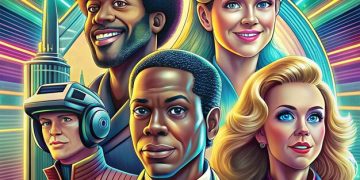Comedy Comebacks: Which Stand-Up Stars Are Making Waves in 2025?

In 2025, the comedy landscape is witnessing a vibrant resurgence as established stand-up veterans and unexpected talents stage powerful comebacks, redefining humor and connecting with diverse audiences through fresh perspectives and deeply personal narratives.
The world of stand-up comedy is cyclical, much like fashion or music trends, with stars emerging, fading, and often, triumphantly returning. As we look ahead to 2025, the stage is set for a fascinating array of comedic talents to reclaim the spotlight, offering fresh perspectives and reigniting laughter. From seasoned veterans refining their craft to unexpected phoenixes rising from the ashes of hiatus, the question on many fans’ minds is: Comedy Comebacks: Which Stand-Up Stars Are Making Waves in 2025? This promises to be a year where the art of the laugh gets a serious, and often hilarious, shake-up.
The Resurgence of Seasoned Veterans
For many stand-up comedians, time away from the constant touring grind can be invaluable. It offers an opportunity for introspection, to gather new material, and to observe the evolving social and political landscape from a fresh vantage point. In 2025, several iconic figures are poised to demonstrate that their absence was far from a retreat, but rather a strategic period of recalibration, ready to deliver comedic gold that resonates deeply with contemporary audiences.
The concept of ‘seasoned veterans’ in comedy is not merely about age, but about the depth of their experience, their command of the stage, and their ability to connect with audiences on a profound level. These are performers who have refined their acts over decades, understanding the subtle nuances of timing, delivery, and audience engagement. Their comebacks are often anticipated with a unique blend of nostalgia and excitement, as fans wonder how their familiar voices will address new realities.
Reimagining Classic Styles
One of the most compelling aspects of these comebacks is how comedians adapt their classic styles to a new era. They don’t just repeat old jokes; they reinvent themselves while staying true to their comedic roots. This requires immense skill and a keen awareness of what makes humor timeless versus what makes it dated.
- Jerry Seinfeld: Known for his observational humor, Seinfeld is expected to delve deeper into the absurdities of daily life in the mid-2020s, perhaps touching on technology overload or the shifting dynamics of social interaction.
- Eddie Murphy: After a celebrated return to film, Murphy’s potential stand-up resurgence in 2025 could blend his raw energy with a newfound maturity, offering perspectives on fatherhood, legacy, and the entertainment industry’s evolution.
- Whoopi Goldberg: With her unique blend of social commentary and character work, Goldberg’s return to stand-up could tackle pressing societal issues with her signature wit and unflinching honesty, offering a much-needed voice in turbulent times.
These artists understand that while certain comedic principles remain constant, the context in which they are applied changes dramatically. Their ability to fuse their established comedic personas with fresh, relevant material is a testament to their enduring artistry. They bring a wealth of life experience and a nuanced understanding of human nature, which allows their humor to be both universally relatable and uniquely personal. The anticipation surrounding their potential tours and specials is palpable, as audiences eagerly await their take on the world of 2025.
Ultimately, the return of these seasoned veterans is more than just about laughter; it’s about the continuation of a comedic lineage, where the torch of insight and entertainment is passed down or, in this case, triumphantly reclaimed by those who helped define it. Their presence enriches the entire comedic ecosystem, setting a high bar for excellence and reminding us of the enduring power of a well-crafted joke delivered by a master.
Rising from Hiatus: Unexpected Returns
Sometimes, the loudest silence precedes the greatest roar. In the fast-paced world of stand-up comedy, extended breaks are often seen as risky, with the fear of being forgotten looming large. However, 2025 is shaping up to be a year where several comedians, who have been out of the public eye for various reasons, are making unexpected and highly anticipated returns. These comebacks are often driven by personal evolution, a desire to reconnect with an audience, or simply a fresh perspective born from time away from the demanding spotlight. Their absence has, in many cases, only amplified the anticipation for their return.
The reasons for a hiatus can be myriad: focusing on family, pursuing other creative ventures, recovering from personal challenges, or simply needing a break from the relentless schedule of touring. What makes these returns so compelling is the potential for new material forged from these experiences. Audiences are often eager to hear how time away has shaped the comedian’s worldview and, consequently, their comedic voice.
The Power of Fresh Perspectives
A break from the constant churn of the comedy circuit can allow creativity to simmer and new ideas to form. When these artists step back onto the stage, they often bring a distinct freshness, a refined point of view that distinguishes them from those who have remained in continuous production. This renewed energy can be infectious, injecting new life into the comedy scene.
- Dave Chappelle’s Evolving Narrative: While not entirely absent, Chappelle’s selective appearances and highly publicized specials often come after periods of introspection. In 2025, his work is expected to continue exploring complex social themes, challenging audiences while maintaining his unparalleled comedic edge.
- Michelle Wolf’s Sharpened Satire: Following a successful yet intense period in political comedy, Wolf’s return could see her broadening her satirical scope beyond immediate political headlines, tackling societal absurdities with a more nuanced, perhaps even absurd, approach.
- Hannibal Buress’s Unpredictable Jumps: Known for his unconventional delivery and dry wit, Buress’s intermittent live performances suggest a deliberate pacing. His 2025 material might reflect deeper dives into personal anecdotes and observations, maintaining his unique, laid-back yet incisive style.
These comedians often re-emerge not just with new jokes, but with a different relationship to their craft and their audience. The break allows for the accumulation of new life experiences, which naturally translates into richer, more layered comedic material. This isn’t just about performing; it’s about sharing a part of their journey, and audiences are ready to listen and laugh.
The unexpected return of a beloved comedic voice can feel like a gift, a reminder of the unique power of stand-up to connect, provoke, and heal. These artists, by choosing their moment to return, assert their agency and remind us that good comedy is worth the wait. Their comebacks are not merely about scheduled tours; they are about significant cultural moments, promising to leave a lasting impression on the comedic landscape of 2025.
The Evolution of Styles: From Observational to Self-Referential
The landscape of stand-up comedy is constantly shifting, mirroring broader cultural changes. What was once considered cutting-edge humor can quickly become passé, while new forms and approaches emerge to captivate audiences. In 2025, a significant trend among returning comedians is an evolution in their comedic styles, moving beyond traditional observational jokes or strictly anecdotal storytelling towards more nuanced, and often deeply personal, self-referential narratives. This shift reflects a growing audience appreciation for authenticity and vulnerability on stage.

This evolution is not a rejection of traditional forms but an expansion. Comedians are finding new ways to draw humor from their own experiences, insecurities, and unique perspectives, creating a more intimate connection with their audience. It’s a move from merely pointing out universal truths to sharing individual truths, inviting the audience into their internal world.
Blending Personal Narratives with Universal Themes
The most successful style evolutions manage to weave deeply personal stories with themes that resonate universally. This is where the magic happens, as audiences find themselves laughing at situations that are specific to the comedian but emotionally relatable to everyone. It requires immense courage and a willingness to be truly exposed on stage, transforming pain or awkwardness into shared laughter.
- Hasan Minhaj: His “Patriot Act” demonstrated a blend of political commentary with personal narrative. A stand-up return in 2025 might see him further exploring this blend, using his personal journey as an American Muslim to dissect broader societal issues, moving beyond daily news cycles.
- John Mulaney: Known for his sharp observational humor rooted in his life, Mulaney’s recent and ongoing personal journeys have opened new avenues for self-referential comedy previously unexplored. His future work is likely to continue this deeply personal, yet still incredibly funny, introspection.
- Bo Burnham: While primarily known for musical comedy, Burnham’s introspective and often starkly honest portrayals of celebrity and mental health could inspire a new wave of comedians to embrace meta-commentary and internal struggles as central to their acts.
This trend signifies a maturation of comedy as an art form. It’s no longer just about punchlines, but about storytelling, emotional resonance, and challenging the audience to think and feel. Comedians are becoming more adept at using their personal narratives as a lens through which to examine universal human experiences, from anxiety and societal pressures to identity and relationships. The vulnerability displayed on stage creates an unspoken pact between performer and audience, fostering an environment where laughter can be both cathartic and deeply meaningful.
The shift towards self-referential comedy also means that the comedian’s persona is increasingly intertwined with their act. Audiences aren’t just buying a ticket to see jokes; they’re investing in the individual’s perspective and journey. This deepens the connection and ensures that the laughter is not fleeting, but leaves a lasting impression, prompting reflection long after the show ends. In 2025, expect to see more comedians mastering this delicate balance, delivering performances that are as thought-provoking as they are hilarious.
Technological Integration: Podcasts, Streaming, and Virality
The methods by which stand-up comedy reaches its audience have drastically transformed over the past decade, and 2025 promises to further solidify these changes. No longer are comedians limited to live club performances or primetime TV specials. The rise of podcasts, direct-to-consumer streaming platforms, and the pervasive nature of social media and viral content have created new avenues for comedians to connect with fans, build personal brands, and sustain careers. For those making comebacks, leveraging these technological tools is not just an option, but a necessity to reach and reactivate their fan bases and attract new listeners.
This digital evolution means that a comedian’s reach is no longer confined by geographic boundaries. A clip from a special can be shared globally within minutes, a podcast can foster a deeply loyal community, and social media offers a direct line of communication between performer and fan. Comedians no longer wait for television networks; they build their own empires.
Building Digital Empires for Comedic Reach
The most successful comeback artists in 2025 will be those who master the art of digital self-promotion and content distribution. This involves more than just posting tour dates; it requires strategic content creation across multiple platforms, designed to engage, entertain, and convert casual viewers into dedicated followers. The ability to craft viral moments from their acts or daily observations is a significant asset.
- Podcast Dominance: Many comedians now host their own successful podcasts, allowing them to hone new material, interview fellow artists, and engage in long-form discussions that showcase their personalities beyond punchlines. This builds a loyal, engaged audience eager for their stand-up.
- Streaming Platform Exclusives: Deals with major streaming services like Netflix, HBO Max, or even independent platforms are crucial. These platforms provide massive reach and allow comedians to present their full specials to a global audience, often with significant production value.
- Short-Form Video Virality: Platforms like TikTok, Instagram Reels, and YouTube Shorts have become essential for sharing bite-sized comedic moments. A perfectly timed joke or a relatable observation can go viral, driving curious new fans to discover the comedian’s longer-form work.
The integration of technology extends to how comedians refine their craft. They can test jokes on podcasts, use social media to gauge audience reaction to potential bits, and even stream live shows to gather immediate feedback. This iterative process, fueled by digital tools, allows for more dynamic and responsive joke development. It also enables comedians to stay connected with their audience even when not actively touring, creating a continuous feedback loop and maintaining relevancy. For comeback artists, this multi-platform approach is vital for ensuring that their return is not just a brief flash, but a sustained presence in the public consciousness.
Ultimately, technology has democratized the comedy industry, allowing talent to bypass traditional gatekeepers and build direct relationships with their fans. For comedians making waves in 2025, a deep understanding and strategic utilization of these digital tools will be as important as their stage presence and timing, securing their place not just in comedy clubs, but across the vast digital landscape.
The Business of Laughter: Tours, Specials, and Deals
Beyond the creative aspect of their art, stand-up comedy is a significant business. For comedians making substantial comebacks in 2025, their trajectory is often defined by strategic business decisions involving global tours, lucrative streaming specials, and innovative brand deals. The industry has evolved from simple club bookings to sophisticated multi-platform entertainment enterprises. Successful comebacks aren’t just about sharp jokes; they’re about smart management, savvy negotiations, and understanding market demand.

The financial stakes for stand-up comedy have never been higher. With streaming services investing heavily in exclusive content, and live touring becoming a major revenue stream, comedians and their teams are constantly looking for the most impactful ways to monetize their talent and reach the widest audience possible. This involves balancing artistic integrity with commercial viability, a challenge that few artists navigate with grace.
Crafting a Comeback Strategy: Beyond the Mic
A successful comeback in 2025 involves a meticulously planned strategy that extends far beyond just writing new material. It encompasses a careful orchestration of live appearances, media partnerships, and brand building. The biggest names often have dedicated teams managing their schedules, securing venues, and negotiating multi-million-dollar deals.
- Mega-Tours and Global Reach: Many returning stars embark on extensive global tours that span continents, allowing them to connect with diverse audiences and generate significant revenue. These tours are often announced far in advance, building anticipation.
- Exclusive Streaming Special Deals: Landing a multi-special deal with a major streaming platform (like Netflix, Prime Video, or Max) is often the pinnacle of a comedian’s comeback. These deals offer massive upfront payments and guarantee global distribution, cementing their cultural impact.
- Brand Partnerships and Endorsements: Increasingly, comedians are leveraging their personal brands for endorsements or partnerships with companies that align with their persona. This adds another layer of income and broadens their audience reach beyond traditional comedy venues.
- Merchandise and Fan Engagement: From apparel to unique collectibles, merchandise sales are a vital part of a comedian’s revenue stream. Engaging directly with highly dedicated fans through exclusive content or fan club initiatives also helps build a sustainable career.
The business side of stand-up comedy has become as complex and competitive as any other major entertainment industry. Comedians are, in essence, running small businesses, responsible for their own careers, brands, and financial futures. For those staging a comeback, a clear understanding of market trends, audience demographics, and negotiating power is crucial. The ability to craft not just a hilarious set, but also a smart business strategy, is what will truly define their success and longevity in 2025 and beyond.
Ultimately, the marriage of comedic artistry with astute business acumen is what separates transient success from sustained relevance. The comedians making the biggest waves in 2025 are not just funny; they are strategic thinkers, entrepreneurs, and masters of their own destiny in an ever-evolving entertainment landscape.
Future Horizons: New Voices and Emerging Trends
While the focus often remains on established names, the vibrancy of the stand-up comedy scene thrives on the constant influx of new voices and the emergence of fresh trends. As we look to 2025, the landscape is not just about comeback kings and queens; it’s also about the innovators and boundary-pushers who are shaping the future of laughter. These emerging talents often bring radically different perspectives, challenging conventional comedic structures and tackling subjects that resonate with younger, more diverse audiences. Their rise dictates the future direction of comedy as much as the return of veterans.
The beauty of stand-up lies in its constant evolution. What makes people laugh is a reflection of societal norms, anxieties, and aspirations. New comedians, often reflecting a younger demographic and different cultural backgrounds, are inherently positioned to identify and exploit emerging comedic territories. Their raw energy and unfiltered voices are essential for keeping the art form vital and relevant.
Redefining Comedy for a New Generation
The emerging trends are characterized by a greater emphasis on authentic storytelling, often intertwined with social commentary, and a willingness to transcend traditional genre boundaries. This signals a broadening of what “comedy” can be, embracing vulnerability, absurdity, and even a degree of didacticism, all within a humorous framework. The new wave is less about set-up/punchline and more about narrative arcs and emotional journeys.
- Authenticity and Vulnerability: Younger comedians are increasingly comfortable sharing deeply personal struggles, mental health journeys, and identity explorations on stage, turning their lived experiences into relatable humor.
- Social Commentary with Nuance: While political humor has always existed, new voices are finding more intricate ways to weave social commentary into their sets, often highlighting systemic issues through personal anecdotes rather than broad pronouncements.
- Genre Blending: Some emerging acts are integrating elements of performance art, theatricality, or even academic lecture into their comedy, pushing the boundaries of what a stand-up show can entail. This makes their performances unique and memorable.
- Digital Native Comedians: Many new stars are first achieving fame on platforms like TikTok or YouTube, developing a comedic style perfectly suited for viral consumption, before transitioning to traditional stand-up stages.
The future horizons of comedy in 2025 are bright and diverse. These new voices are not just creating jokes; they are fostering conversations and building communities around shared experiences and unique perspectives. They are leveraging the democratizing power of the internet to find their niche audiences, allowing them to bypass traditional gatekeepers and build independent careers. Their experimentation and willingness to take risks are vital for the continued innovation of stand-up, ensuring that the art form remains fresh, relevant, and capable of surprising and delighting audiences for years to come.
Ultimately, the comedic landscape of 2025 is a vibrant ecosystem where seasoned veterans inspire and challenge, while new voices disrupt and redefine. This dynamic interplay ensures that comedy remains a powerful mirror reflecting our changing world, always ready to find the humor in the human condition, no matter how complex or challenging.
| Key Figure/Trend | Brief Description |
|---|---|
| 🎭 Seasoned Veterans | Established comedians like Seinfeld and Murphy return, adapting classic styles to modern issues. |
| ✨ Unexpected Comebacks | Comedians like Chappelle and Wolf re-emerge after hiatus, bringing refreshed perspectives. |
| 🔄 Evolving Styles | Shift towards self-referential humor, blending personal narratives with universal themes (e.g., Mulaney). |
| 🌐 Tech Integration | Podcasts, streaming specials, and viral short-form content are key for broad reach and deeper engagement. |
Frequently Asked Questions About Comedy Comebacks
▼
Several factors contribute to this trend, including creative rejuvenation after a hiatus, a changing social landscape providing new material, and the emergence of diverse distribution channels like streaming platforms and podcasts, which offer unprecedented reach and control over their content. Personal growth also plays a significant role in their renewed artistic drive.
▼
Streaming platforms, such as Netflix, Max, and Prime Video, have revolutionized comedy comebacks by offering global distribution and significant financial incentives. They allow comedians to reach a massive, diverse audience instantly, bypassing traditional network gatekeepers and providing a dedicated space for their full-length specials, making returns highly visible and profitable.
▼
Veteran comedians bring decades of stage experience, refined timing, and a deep understanding of audience dynamics. Their comebacks often feature a unique blend of nostalgic appeal with fresh, mature perspectives on contemporary issues, filtered through their established comedic voices. This allows them to connect with both long-time fans and new audiences.
▼
Yes, 2025 comebacks are showcasing a significant shift towards more self-referential and autobiographical humor. Comedians are increasingly integrating personal narratives, vulnerabilities, and nuanced social commentary into their acts, moving beyond simple observational comedy. This creates a deeper, more authentic connection with the audience and reflects evolving audience preferences.
▼
Social media is immensely important. Platforms like TikTok, Instagram, and YouTube allow comedians to build and reactivate their fan bases, test new material, and create viral moments. It offers a direct line of communication with fans, helps in promoting tours and specials, and builds a consistent digital presence, crucial for sustained relevance in the modern comedy landscape.
Conclusion
As we navigate through 2025, the dynamic landscape of stand-up comedy is undoubtedly enriched by the powerful return of both beloved veterans and surprising figures from hiatus. These comedy comebacks are not merely a nostalgic revisitation of past glories, but a vibrant testament to the enduring power of laughter and the adaptability of comedic artistry. From refining classic styles for new generations to embracing personal storytelling and leveraging technological advancements, the stars making waves are redefining what it means to be a contemporary comedian. Their continued evolution ensures that stand-up remains a vital, intelligent, and deeply resonant art form, offering much-needed insights and shared moments of joy in an ever-changing world.





